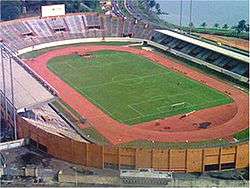Stade Félix Houphouët-Boigny
| Le Félicia | |
 | |
| Full name | Stade Félix Houphouët-Boigny |
|---|---|
| Former names | Stade Géo André |
| Location | Le Plateau, Abidjan nord, Abidjan |
| Capacity | 45,000[1] |
| Field size | 105m x 68m |
| Surface | Grass |
| Construction | |
| Opened | 1952 |
| Renovated | 1964, 2009 |
| Tenants | |
| ASEC Mimosas | |
Stade Félix Houphouët-Boigny, nicknamed "le Félicia", is a multi-purpose stadium, which can host football, rugby union and athletics, in Abidjan, Côte d'Ivoire. It is the national stadium of the Côte d'Ivoire national football team. It is named after the first president of the country, Félix Houphouët-Boigny, and is located in the commune of Le Plateau. The stadium has a capacity of 45,000.[2] It also hosts matches of the ASEC Abidjan. It has been the site of several deadly stampedes.
History
Built in 1964 to organize the "Games of Abidjan", the stadium was formerly known as Stade Andre Geo, and it took the name of the President Felix Houphouet-Boigny after undergoing restoration.
Gradually it emerged as the National Stadium, hosting the ASEC Mimosas and Ivorian Soccer Team.
Along the Stadium of Peace of Bouake, Stade Felix Houphouet-Boigny hosted Africa Cup of Nations soccer. In 2009 after a complete renovation, which included lawn seating and the treatment room, the stadium hosted the 2009 African Championship of Nations.
The stadium is being renovated for the 2017 Jeux de la Francophonie.[3]
The stadium played host to Amnesty International's Human Rights Now! Benefit Concert on October 9, 1988. The show was headlined by Sting and Peter Gabriel and also featured Bruce Springsteen & The E Street Band, Tracy Chapman and Youssou N'Dour.
The American singer Chris Brown finished his Carpe Diem Tour at this stadium on December 30, 2012.
Incidents
On March 29, 2009, during the match between Ivory Coast and Malawi, the gateway to an open corner of the stadium gave way before the kick-off of the match. A stampede ensued when 19 people were killed by trampling. Over 130 were injured as well.
On January 1, 2013, following a New Year's Eve fireworks display, another stampede took place, in which sixty-one lives were claimed, with upwards of 200 injuries sustained.[4]
Structure
The bleachers painted in national colors consist of curves, the gallery lagoon side of the podium, a gallery and a presidential box, VIP, and BVIP .
The stage contains a media room, a room control anti-doping, a VIP room, a treatment room, offices of arbitrators, a massage room, not to mention four dressing rooms.
The stadium has a video board 220 volts for 35 kwh, 16.50 meters by 5.70 meters.
The lawn is of international standard and is maintained daily green and glowing.
References
- ↑ http://nl.soccerway.com/national/cote-divoire/ligue-1/20132014/regular-season/r22910/venues/?ICID=PL_3N_05
- ↑ http://stadiumzone.weebly.com/
- ↑ "CHANTIERS DES JEUX DE LA FRANCOPHONIE (French)".
- ↑ Bakayoko, Inza (2013-01-01). "Stampede After Fireworks Kills 61 in Ivory Coast". Time. Retrieved 2013-01-02.
External links
| Wikinews has related news: Stadium disaster claims lives at football World Cup qualifier match in Ivory Coast |
| Preceded by June 11 Stadium Tripoli |
African Cup of Nations Final Venue 1984 |
Succeeded by Cairo International Stadium Cairo |
Coordinates: 5°19′41.7″N 4°1′6.3″W / 5.328250°N 4.018417°W